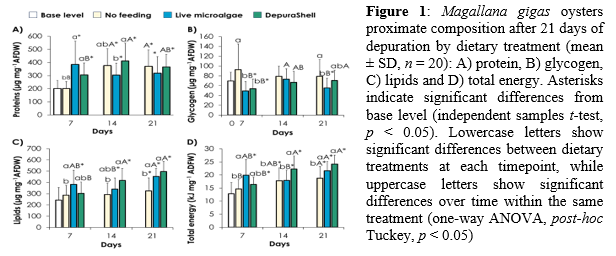DEPURASHELL: A NOVEL MICROBIOLOGICALLY-SAFE MICROALGAE DIET FOR ENHANCED RELAYING AND DEPURATION OF THE OYSTER Magallana gigas
Introduction
Bivalves harvested or reared in areas with high microbiological contamination require depuration in clean seawater without food for 1–3 days, or longer in relaying facilities, to ensure safety for human consumption(1). However, this starvation period can impair survival, physiological condition, health, and nutritional value, challenging their marketability(1). To mitigate these effects, safe and nutritionally balanced microalgae-based diets for depuration are essential for enhancing bivalve welfare, quality, and producers’ revenues. However, the production of live microalgae in hatcheries for bivalve nutrition represents 30-50% of total operational costs(2) and poses logistical and technical challenges, driving the pursue for alternative and cost-effective commercial microalgal feed solutions. Microalgae liquid concentrates have emerged as a promising option, offering several advantages such as ready-to-use diets, year-round availability, consistent quality, and nutritionally adequate profiles. However, existing commercial products hinder their application in relaying and depuration since they are not adapted to these aquaculture systems and contain high microbial loads, which can compromise their technical application, as well as feed safety, stability, shelf-life, and bivalve performance. High microbiological loads in diets degrade water quality, disrupt organisms’ gut microbiota, and weaken their immune system(3). Therefore, improving the microbial quality of these diets is crucial, especially for depuration, which requires bacteriologically clean water(1). Thermal treatments efficiently reduce the bacterial load in microalgae liquid concentrates, making them promising for use in depuration system diets(4). This study aims to develop a novel microbiologically-safe, nutritionally balanced microalgae diet (DepuraShell) to improve the quality of Pacific oysters (Magallana gigas) during depuration, while being technically adapted to Recirculation Aquaculture Systems (RAS). For that purpose, the organism’s biological performance was evaluated during depuration and shelf-life storage, focusing on oysters’ physiological status.
Material and Methods
The previously selected strategy to lower the bacterial load of microalgae liquid concentrates was low-temperature long-time (LTLT) pasteurization (75±2ºC, 1h, followed by a 10ºC cold shock) due to its efficiency in lowering bacteria, without causing cell agglomeration, sedimentation, or degradation of key pigments. The LTLT-treated DepuraShell pilot diet was formulated as a liquid concentrate with 8% algal dry weight (DW), containing Tetraselmis chui, fortified with docosahexaenoic acid (DHA), and supplemented with carbohydrate-rich ingredients. LTLT was applied to the diet and frozen until its usage. A 28-day trial was conducted in three closed 250L depuration modules with ultrafiltered and UV-treated recirculating seawater (15°C, salinity 35), each equipped with a protein skimmer. Oysters (n=354) were assigned to three feeding treatments: (1) live microalgae (Tisochrysis lutea + Tetraselmis sp., 3:2 ratio; (3% of oyster DW (g) in algal DW (g)/day), (2) LTLT-treated DepuraShell diet; (8% of oyster DW (g) in diet DW (g)/day), and (3) an unfed control. Oysters were fed twice daily for 21 days, followed by 7 days of storage at 4°C (shelf-life simulation). Daily survival was recorded, Escherichia coli levels (Most Probable Number, MPN) were quantified at 0 and 18h, and weekly assessments included condition index (CI), proximate composition (proteins, glycogen, lipids, total energy), and biometric parameters (wet weight, length, width, thickness). Fatty acids profiles were analysed at day 0, day 21, and day 28.
Results and Discussion
Results showed effective depuration in all treatments, with E. coli levels dropping from 1300 to <18 MPN/100g within 18h. Survival remained near 100% across all treatments throughout the 21-day trial. Oysters fed with DepuraShell diet exhibited significantly higher shell length (91.26±9.46 mm) and wet weight (74.38±7.86 g) compared to the base level. During this period, DepuraShell also significantly improved oyster’s CI compared to the unfed control, with no significant differences compared to live microalgae. DepuraShell-fed oysters accumulated significantly higher lipid (496±89.66 µg.mg-1 ash free dry weight (AFDW)) and total energy reserves (24.14±3.45 kj.mg-1 AFDW) at day 21, compared to unfed oysters, mitigating the typical lipid depletion observed in food-deprived bivalves during the depuration process. Glycogen reserves were mobilized in fed groups due to higher metabolic activity, in contrast to the unfed condition, where lower metabolic activity occurred due to the absence of feed. These oysters also exhibited significantly higher DHA and eicosapentaenoic acid (EPA) levels (26.94±0.66; 15.45±0.75% of total fatty acids, respectively), and had significantly higher n-3/n-6 (9.53±0.72), DHA/EPA (1.75±0.12), and PUFA/SFA (1.85±0.08) ratios compared to the unfed group, making it an excellent alternative to standard depuration without feeding. During the 7-day shelf-life period, survival remained at 100%, and oysters’ CI, along with protein, lipid, and total energy levels, were maintained in DepuraShell-fed oysters.
In conclusion, DepuraShell is a nutritionally balanced diet, technically adequate for RAS systems, that enhances M. gigas commercial value during relaying and depuration by improving growth, body condition, nutritional quality and fatty acid profile, while guaranteeing microbiological safety for human consumption.
Acknowledgements
Supported by Project SHELLBLOOM-17410 (ALGARVE 2030, COMPETE2030-FEDER-01193100, Portugal 2030) and FCT doctoral scholarship 2022.09708.BDANA
Bibliography
1) Lee, R., Lovatelli, A., et al. (2008). Bivalve depuration: fundamental and practical aspects. FAO Fish. Tech. Pap. No. 511. Rome, FAO
2) Oostlander, P. C., van Houcke, J., et al. (2020). DOI: 10.1016/j.aquac ulture.2020.735310
3) Zannella, C., Mosca, et al. (2017). DOI: 10.3390/md15060182
- Dan, S., Ashidate, et al. (2018). DOI:10.1111/are.13822
